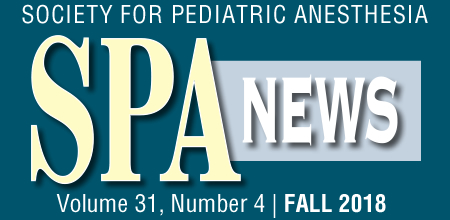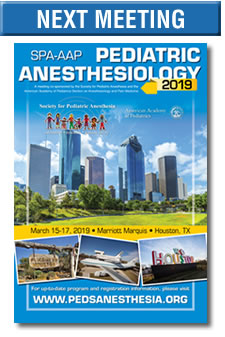meeting reviews
Session II: The Nervous System... And What We Do to It
Moderator: Lena S. Sun, MD
Reviewed by: Rita Agarwal MD, FAAP, FASA
Stanford University
The second session of the morning was opened by a panel discussing “Perspective on Opioids”, hosted by Myron Yaster, MD (University of Colorado). The first speaker was Charles Berde, MD, PhD (Boston Children’s Hospital) who wove the fascinating story of two Nobel Laureates and their efforts to use basic cell biology to create a better analgesic, in a lecture called “Can Translational Research Lead to Safer, More Effective Opioids?”. Opioid receptor binding activates second messengers and intracellular pathways that include Gs (Stimulatory), Gi (Inhibitory), β Arrestin, K+ channels, Ca++ channels and Protein Kinases. By ligand biasing, they can alter which second messenger is activated and potentially lead to better analgesia with less side effects. This led to the discovery of Oliceridine (TRV 130), which appears to have fewer side effects, including addiction risk while providing equal analgesia. The drug just underwent FDA review and was rejected, with a request for more safety information.
Constance Monitto, MD (Johns Hopkins) reviewed the concept of opioid stewardship and the excessive numbers of opioids that are written for children in the post-operative period. She emphasized the importance of educating surgeons, families and patients on appropriate use, and disposal of these medications. Excess medications in households may promote non-medical use of opioids. The hazard of heroin use is increased 13 fold in adolescents who have a history of non-medical use of opioids.
The final speaker on the panel was Sophie Pestieau, MD (Children’s National Health System) who enlightened us with “Methadone Pearls”. She reviewed the history (Hitler and the Nazis!), and current literature on dosing, pharmacology and uses of the drug and the unique characteristics of methadone. The unique characteristics include its multiple receptor affinities, rapid onset and prolonged elimination half-life. Interestingly, Dr. Pestieau’s talk generated the highest number and variety of electronically transmitted questions. One of the key take home messages from Dr. Pestieau’s talk was that the loading dose of methadone mattered.
The second topic of this interesting session was on “Neurotoxicity: What’s New for 2018”, given by Emmett Whitaker, MD (University of Vermont Larner College of Medicine). Dr.Whitaker did a lovely job reviewing the basic science and recent pre-clinical studies that continue to show an impact on learning, memory, socialization and anxiety in animals, with a variety of agents. Disturbingly, these studies show these types of changes in animals as large as non-human primates. He then shifted into the studies on human children. There are several studies with contradictory results. The Mayo Anesthesia Safety in Kids study looked at a matched cohort of children and found no effect from a single anesthetic on general intelligence, processing speed, executive function, or behavior. However, children exposed to multiple anesthetics (and surgeries) did have more problems with executive function, behavior and processing speed.
Other interesting studies showed that hypotension is common in infants undergoing pyloromyotomy, as is mild to moderate low cerebral saturation. There did not seem to be an association between blood pressure and cerebral oxygenation. A large population based study from New South Wales did find poorer development at school entry and worse performance if children had been exposed to anesthesia prior to age 4. When limited to one exposure the association was attenuated. Xenon did not help with short term neurocognitive deficits in a group of children undergoing cardiac catheterization, with either sevoflurane alone or xenon augmented sevoflurane. Children who received xenon augmented sevoflurane did, however, have a lower incidence of hypotension.
The final lecture of this session was truly remarkable and futuristic. Alan Flake, MD, FACS, FAAP, a pediatric surgeon from Children’s Hospital of Philadelphia, discussed his research on creating and using an artificial womb. Babies born extremely premature have significant mortality and morbidity that often arise from inadequate organ maturity. While survival for extremely low birth weight infants has increased, there has been no improvement in major morbidities. An extra-uterine fluid environment has the potential to allow lungs to continue to grow and mature, facilitate normal fluid balance, provide trophic factors for gut maturation, and isolate the newborn from environmental pathogens.
The creation of an artificial womb has been the stuff of science fiction for decades (Aldous Huxley’s A Brave New World), but is fraught with challenges. Dr. Flake and his colleagues’ goal was to create a pumpless oxygenator circuit that could be connected via the umbilical circulation and maintain normal homeostasis. They have developed a “biobag” that is a completely closed, translucent, sonolucent system and seems to have solved the problem of infection and sepsis in fetal lambs. The new system allows the lambs to maintain hemodynamic stability, grow appropriately, develop and mature lung morphology, surfactant, and brain anatomy and function. The results in lambs have been extremely promising and includes one named Fred Astaire who after undergoing cognitive and executive functioning was found to be smarter than the average sheep! Many challenges exist, but the future looks bright.






